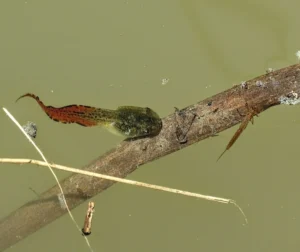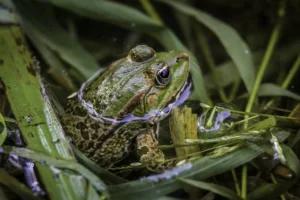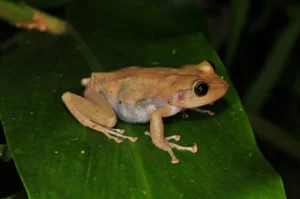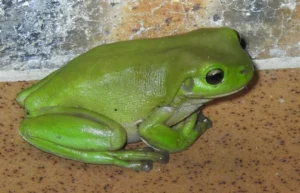Many people know that most frogs love to hang around water and are very efficient swimmers. But have you ever wondered if frogs can survive without direct access to water?
Most frogs can not survive without direct access to fresh water. Frogs generally require access to water to keep their skin moist, hydrate, lay their eggs, and for their tadpoles to develop.
However, a few frog species such as the Common Coqui (Eleutherodactylus coqui) can survive without direct access to water.
These frogs lay eggs in protected terrestrial environments, and hatch into fully developed frogs which are morphologically similar to the adults.
This is known as ‘direct development’, and skips the tadpole stage entirely.
Such reproductive behavior enabled Common Coquis to live in forests, mountains, and even in urban areas – without the limitation of a direct dependency on water.
Australian green tree frogs (Litoria caerulea) have also been found to be able to survive for several months without access to water – by ‘fogging up’ like a pair of glasses (more information on that is below).
Most Frogs Start Their Lives in Water
The majority of frog species lay their eggs in shallow, standing, or slow-moving freshwater bodies that are free of predatory fish.
This could be in woodland ponds, seasonal pools, temporary rain puddles, flooded ditches, lake edges, river backwaters, bogs, marshes, swamps, and even in deep tire tracks or potholes filled with rainwater
After a few days, to a few weeks, tiny tadpoles hatch from these eggs. Tadpoles are very different from adult frogs; this is because they’re adapted for a fully aquatic life (life in the water), while adult frogs are adapted for a semi-aquatic, or mostly terrestrial life (depending on the species).

The tadpoles have gills, and live entirely in the water, just like fish.
Over time, the tadpoles will go through a process known as metamorphosis in which they will transform into juvenile frogs.
During metamorphosis, the thyroid gland secretes a growth hormone called thyroxine.
This hormone triggers the tadpoles to:
- Lose the gills, and develop lungs for breathing air
- Absorb the tail into the body
- Grow strong legs for moving on land
- Remodel other organs to form an adult frog

Once this process is complete, tiny froglets will leave the water for a mostly terrestrial life.
These young frogs will grow into adult frogs over time, and once they mature, they will return to the water to breed.
Most Adult Frogs Need Direct Access to Water to Survive
Although adult frogs can survive on land, most species still require direct access to water to survive.
They usually hang around cool, humid, shaded areas near ponds, swamps, streams, lakes, and other water bodies.
Frogs and other amphibians have unique skin compared to that of many other vertebrates. Their skin is composed of thin membranous tissue that is quite permeable to water and contains a large network of blood vessels.

This permeable skin distinguishes them from mammals, birds, or reptiles.
Permeability relates to how easily a gas or liquid molecule can pass back and forth from the environment into the animal and vice versa.
Typically, the larger the molecule, the more difficult it is to enter the animal through its skin. Amphibian skin is more permeable than that of other vertebrates.
Their membranous skin allows water and respiratory gases to readily diffuse directly down their gradients between the blood vessels and the surroundings.
To efficiently breathe via their skin, frogs have to keep their skin constantly moist by secreting a special mucous coating (which gives them a slimy feeling when touched).

Frogs can only breathe through their skin if the skin stays moist. If it dries up, they can suffocate and die.
For this reason, frogs generally need to have access to water to rehydrate so they can keep their skin moist.
Dehydration can be harmful, and even potentially lethal to most frogs. Their need for water is as critical as their need for food or oxygen–it’s an essential substance, that keeps their bodies working normally.
See also: How Do Frogs Drink Water?
Most Frog Species Also Need Water to Reproduce
The vast majority of frog species require water to successfully reproduce.
Frogs typically lay their eggs in shallow, standing, or slow-moving freshwater bodies that are free of predatory fish.
This could be in woodland ponds, reservoirs, seasonal pools, river margins, lake edges, river backwaters, bogs, marshes, swamps, temporary rain puddles, and even in roadside ditches, deep tire tracks, or potholes filled with rainwater.

Some frog species such as the American green tree frog (Hyla cinerea) occasionally lay their eggs in water bodies with fish.
Other frog species such as the Coastal Tailed Frog (Ascaphus truei), and the waterfall frog (Ranoidea nannotis) lay their eggs in fast-flowing streams, and attach them underneath large rocks.
Since these frogs lay their eggs in fast-flowing water, their tadpoles have very strong tails for swimming, and mouths on the underside of their bodies. They use their large sucker-like mouth parts to cling onto rocks so they do not get washed away.
See also: Where Do Frogs Lay Their Eggs?
Some frogs such as the red-eyed tree frog, and glass frogs of South America, do not lay their directly eggs in water. Rather, they lay them on leaves that hang over the water.

When the eggs are ready to hatch, the tadpoles inside start wriggling around, breaking the eggs open.
The tadpoles then wash down the leaf and fall into the pond below.
Some Frogs Can Survive Without Direct Access to Water
Many frog species such as the Common coquí (Eleutherodactylus coqui) evolved to live in environments with low availability of undisturbed surface water to live in.
For this reason, they developed strategies that enable them to survive and thrive without direct access to water.
These frogs can re-hydrate entirely by absorbing moisture from moist soil, or any other moist material, such as damp leaf litter.
To reproduce, frogs such as Common Coquis lay eggs in protected terrestrial environments, which then hatch into young frogs that are morphologically similar to the adults. This is known as ‘direct development.’

Depending on the species, the eggs are laid on leaves, in tree hollows, in caves, under logs, in damp soil or leaf litter, and even in abandoned bird nests.
The eggs of direct-developing frogs are usually extra large because they have a lot of yolk to compensate for the lack of feeding as a tadpole.
The yolk will remain attached to the intestine to nourish the froglets for the first few days after hatching, in a sequence similar to chickens.
Such reproductive behavior allows these frogs to live in forests, mountains, and even in urban areas – without the limitation of a direct dependency on water.
Even frogs that can survive, and reproduce without direct access to water still need to live in humid areas, where they can get all the water they need by absorbing moisture from their environments. If they live in an area without sufficient environmental sources of moisture, they will die.
Australian Green Tree Frogs Can Survive the Dry Season by ‘Fogging Up’
Frogs generally require humid environments to survive.
However, If the humidity levels around them are low, some tree frogs have a more creative way to hydrate.
Researchers from Charles Darwin University in Australia found that Australian green tree frogs (Litoria caerulea) survive the dry season by ‘fogging up’ like a pair of glasses.

On cool nights, Australian tree frogs sit down outside – and when they return to their dens, condensation will form on their cold skin.
This is similar to the condensation that happens when you take a cold drink out of the refrigerator.
The researchers conducted a series of experiments to see if the frogs could collect enough moisture through condensation to compensate for what they lost being in the cold.
They found that a cold night out cost a frog as much as .07 grams of water – but a frog could gain nearly .4 grams, or nearly 1 percent of its total body weight, in water upon returning to the warm den.
The researchers also found that as much as 60 percent of each water drop could be absorbed – proving that frogs can use condensation to rehydrate themselves.
Commonly Asked Questions About Frogs and Water
How long can frogs survive without water? In general, highly aquatic frogs can only survive for a few hours without water outside of hibernation or estivation. Terrestrial frogs, on the other hand, can survive without water from 24 hours to a few days, depending on the species, and environmental conditions.
Can frogs live without water? Like all living creatures, frogs need to consume water to survive. Dehydration can be harmful, and even potentially lethal to most frogs. However, some frogs can survive without direct access to water, as long as they can get all the water they need by absorbing moisture from the environment.
Sources:
Condensation onto the Skin as a Means for Water Gain by Tree Frogs in Tropical Australia. Christopher R. Tracy, Nathalie Laurence, and Keith A. Christian. The American Naturalist 2011 178:4, 553-558
Sarah E Westrick, Mara Laslo, Eva K Fischer (2022) The Natural History of Model Organisms: The big potential of the small frog Eleutherodactylus coqui eLife 11:e73401 https://doi.org/10.7554/eLife.73401
Elinson, Richard. (2001). Direct development: An alternative way to make a frog. Genesis (New York, N.Y.: 2000). 29. 91-5. 10.1002/1526-968X(200102)29:23.0.CO;2-6.


